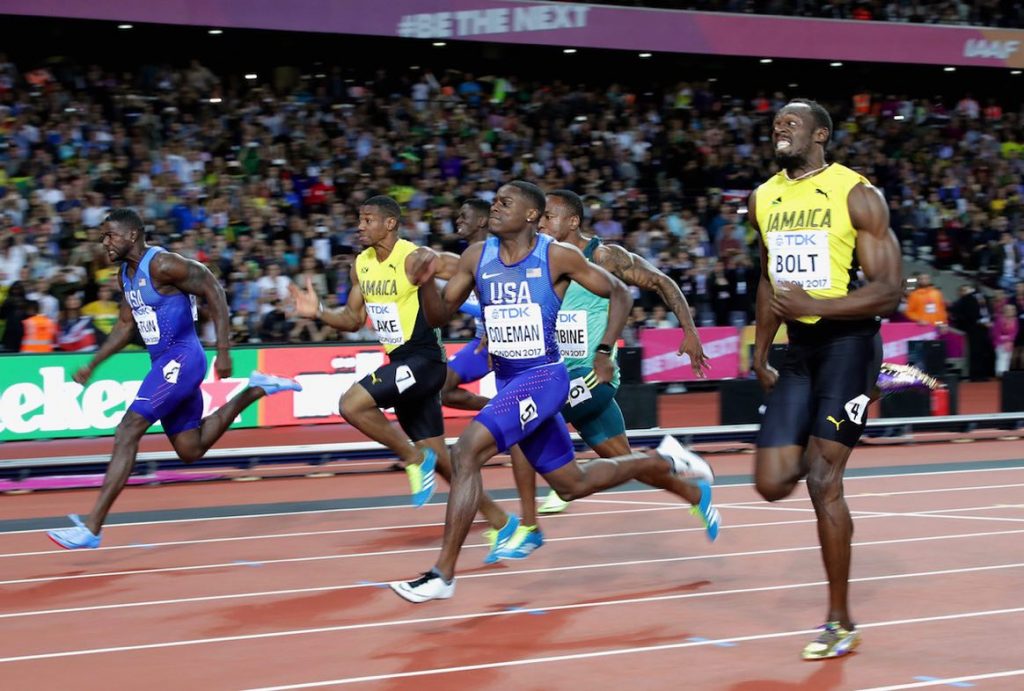In mid 2015 Runner’s Tribe was given permission to re-publish and offer content suggestions to Inside Science which is an editorially independent non-profit science news service run out of the American Institute of Physics and supported by a coalition of underwriters. RT has been following their stories and articles for a number of years now and with a selection of exceptional athletics-related content, it is a pleasure to share some of these articles with our readers.
Using Physics And Other Factors to Explain Usain Bolt’s Speed
Originally posted on Jul 25 2013 - 8:15pm By: Chris Gorski Inside Science Runner's Tribe - August 2017 - 6:49pm
At 6 feet 5 inches, Usain Bolt is tall for a sprinter. His large frame means that he takes fewer steps per race than his opponents, but also comes with a cost: he faces more air resistance. Now, physicists calculate that less than eight percent of Bolt’s energy usage contributed to his motion during his world record-setting performance of 9.58 seconds in the 100 meters at the 2009 World Championships in Berlin.
The remaining 92 percent of his effort worked to overcome the forces of aerodynamic drag.
Researchers from the National Autonomous University of Mexico made these calculations after developing a mathematical model of Bolt’s sprinting performance, published in the European Journal of Physics.
The researchers used data collected by the International Association of Athletics Federations, which captured Bolt’s position and speed every 0.1 seconds. They built a somewhat simplified model, writing that they assumed that he “develops a constant horizontal force” throughout the race.
The data shows that Bolt’s force peaks during the first second of the race, and after that remains relatively consistent. His speed peaked around 7 seconds into the race, at over 27 mph. The researchers calculated a maximum power output of about 3.5 horsepower. Of Bolt’s total work during the race, 81.58 kilojoules, only 6.36 were “used to achieve motion,” they wrote.
Air resistance tends to be highest when a runner reaches top speed. As anyone who has placed a hand through the open window of a moving car knows, even at residential street speeds, the wind force can be considerable.

In addition to velocity, other factors that influence the air resistance faced by a sprinter include elevation, humidity and the body’s shape and surface area.
The researchers’ calculations can also isolate the effect of wind speed on a performance. Without the benefit of the Berlin race’s soft tailwind, Bolt’s time would have been a tenth of a second slower, 9.68 seconds. This would still have beaten the world record at that time, the 9.69 mark Bolt posted at the 2008 Beijing Olympics. The researchers’ model produces estimates of the effect similar to those computed by other methods, they wrote.
If the tailwind had been the maximum speed under which a record can be set, 2.0 meters per second, Bolt would have sped to a world record in 9.46 seconds, the researchers calculated. No other human has ever recorded a faster time than Tyson Gay’s wind-aided 9.68, which he tallied in 2012.
Granted, Gay recently tested positive for a performance-enhancing substance. He denied knowingly taking anything illegal, but says he will not fight the suspension. However, his positive test, and the other recent positive tests of many notable sprinters leave few of Bolt’s peers with clean records with respect to performance-enhancing drugs.
Considering that Bolt is the only man to ever run the 100 meter faster than 9.78 seconds and never serve any drug-related suspension, it’s natural to be a little suspicious of whether Bolt could be clean. From LetsRun.com’s Robert Johnson, here’s one approach that explains why Bolt might indeed be clean and still dominate the sport.
Without saying Bolt is certainly clean, Johnson points to two major factors to explain why he may be a different category of sprinter. His height is combined with the “coordination and quickness of sprinters who are normally much smaller,” Johnson wrote, and Bolt had exceptional success at a young age. The argument suggests that Bolt is the sprinting equivalent of baseball’s Babe Ruth — an evolutionary jump that separates a transcendent athlete from his peers.
The Associated Press covered Bolt’s statements that his success has been achieved without doping, at a recent media event in London:
“If the recent cases have cast doubt about Bolt’s integrity, the 100- and 200-meter world-record holder asked skeptics to check his résumé.
‘If you were following me since 2002, you would know that I have been doing phenomenal things since I was 15,’ the 26-year-old Bolt said. ‘I was the youngest person to win the world juniors at 15. I ran the world junior [200] record 19.93 at 17. … I have broken every record there is to break, in every event I have ever done.'”






























Comments are closed.